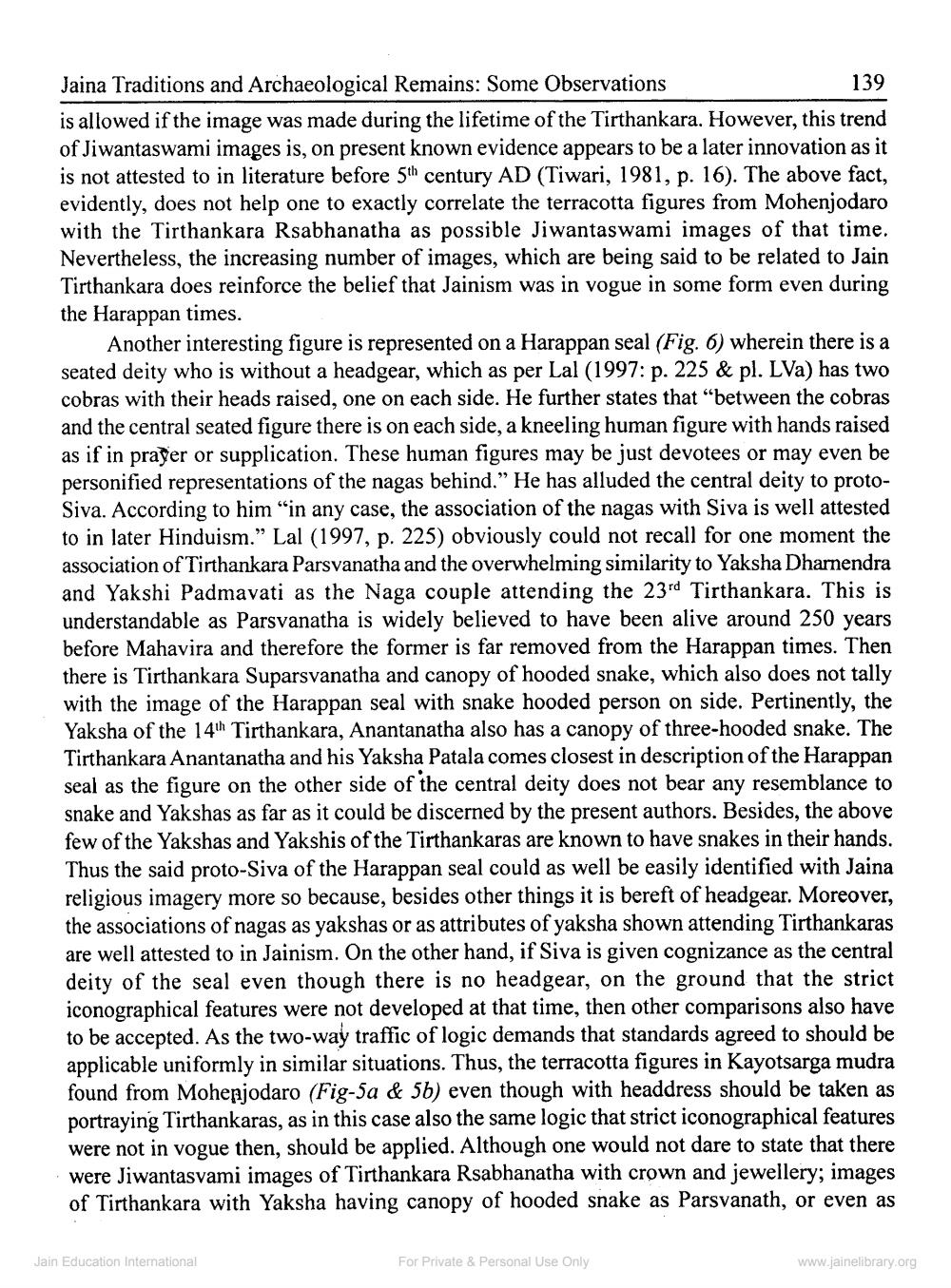________________
139
Jaina Traditions and Archaeological Remains: Some Observations is allowed if the image was made during the lifetime of the Tirthankara. However, this trend of Jiwantaswami images is, on present known evidence appears to be a later innovation as it is not attested to in literature before 5th century AD (Tiwari, 1981, p. 16). The above fact, evidently, does not help one to exactly correlate the terracotta figures from Mohenjodaro with the Tirthankara Rsabhanatha as possible Jiwantaswami images of that time. Nevertheless, the increasing number of images, which are being said to be related to Jain Tirthankara does reinforce the belief that Jainism was in vogue in some form even during the Harappan times.
Another interesting figure is represented on a Harappan seal (Fig. 6) wherein there is a seated deity who is without a headgear, which as per Lal (1997: p. 225 & pl. LVa) has two cobras with their heads raised, one on each side. He further states that “between the cobras and the central seated figure there is on each side, a kneeling human figure with hands raised as if in prayer or supplication. These human figures may be just devotees or may even be personified representations of the nagas behind." He has alluded the central deity to protoSiva. According to him “in any case, the association of the nagas with Siva is well attested to in later Hinduism.” Lal (1997, p. 225) obviously could not recall for one moment the association of Tirthankara Parsvanatha and the overwhelming similarity to Yaksha Dharnendra and Yakshi Padmavati as the Naga couple attending the 23rd Tirthankara. This is understandable as Parsvanatha is widely believed to have been alive around 250 years before Mahavira and therefore the former is far removed from the Harappan times. Then there is Tirthankara Suparsvanatha and canopy of hooded snake, which also does not tally with the image of the Harappan seal with snake hooded person on side. Pertinently, the Yaksha of the 14th Tirthankara, Anantanatha also has a canopy of three-hooded snake. The Tirthankara Anantanatha and his Yaksha Patala comes closest in description of the Harappan seal as the figure on the other side of the central deity does not bear any resemblance to snake and Yakshas as far as it could be discerned by the present authors. Besides, the above few of the Yakshas and Yakshis of the Tirthankaras are known to have snakes in their hands. Thus the said proto-Siva of the Harappan seal could as well be easily identified with Jaina religious imagery more so because, besides other things it is bereft of headgear. Moreover, the associations of nagas as yakshas or as attributes of yaksha shown attending Tirthankaras are well attested to in Jainism. On the other hand, if Siva is given cognizance as the central deity of the seal even though there is no headgear, on the ground that the strict iconographical features were not developed at that time, then other comparisons also have to be accepted. As the two-way traffic of logic demands that standards agreed to should be applicable uniformly in similar situations. Thus, the terracotta figures in Kayotsarga mudra found from Mohenjodaro (Fig-5a & 5b) even though with headdress should be taken as portraying Tirthankaras, as in this case also the same logic that strict iconographical features were not in vogue then, should be applied. Although one would not dare to state that there were Jiwantasvami images of Tirthankara Rsabhanatha with crown and jewellery; images of Tirthankara with Yaksha having canopy of hooded snake as Parsvanath, or even as
Jain Education International
For Private & Personal Use Only
www.jainelibrary.org




